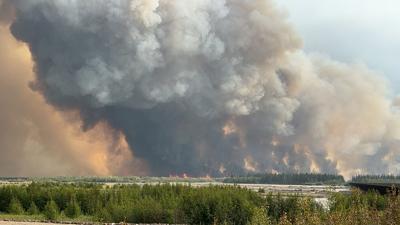The snowpack is receding fast, breakup is underway, and with it comes one of Interior Alaska’s most dangerous transitions of the year: wildfire season.
April and May may seem early to worry about wildfires, but they are historically two of the riskiest months in the region. That’s because, before greenup — the day when trees and shrubs burst into leaf — our landscape is primed for ignition. Dry grasses, leaf litter and dead vegetation are exposed to sun and wind while the snowpack recedes. One spark, one careless fire, and conditions can quickly turn volatile.
This year’s warning signs are already clear. Record-low snowpack south of the Alaska Range forced the Iditarod to move to its northern route. That same lack of snow has also prompted the Alaska Division of Forestry & Fire Protection to declare an early start to fire season in its Coastal Region, where at least 17 fires had already required response by early April — many due to careless burning. In Interior Alaska, where below-normal snow was also reported, those same dry, dangerous conditions are setting in fast.
Now is the time to act. Homeowners should create defensible space by clearing brush, trimming branches, and removing flammable debris near homes and structures. Access roads should be clear for emergency vehicles. Alaskans burning yard waste should follow the guidelines outlined on the state’s “Learn Before You Burn” website (dnr.alaska.gov/burn) and you should never burn on a windy day or leave a fire unattended.
The risk isn’t limited to backyard fires. Sparks from ATVs, chainsaws or even vehicles driven over dry grass can start a blaze. Early spring recreational users should stay alert and avoid driving or parking on vegetation. If you see smoke or flames, call 911 or 1-800-237-3633 immediately. An early response can prevent a full-blown emergency.
Local, state and federal fire crews are already preparing for what could be an active season, especially in wildland-urban interface zones like those found throughout the Fairbanks North Star Borough. The borough has invested in community fuel breaks and wildfire mitigation, and those efforts deserve continued public and political support.
Prevention isn’t just about policy. It’s about personal responsibility.
And there’s a broader context with which we must cope: Alaska’s wildfire season is growing. Research from the University of Alaska Fairbanks shows that spring snowmelt is occurring nearly two weeks earlier than it did in the 1990s. That early melt correlates with longer, more intense fire seasons across tundra and boreal regions. The new “Alaska’s Changing Wildfire Environment” report highlights how wildfires are growing in frequency, size and scope across the state.
Interior Alaska knows how to live with fire. We’ve done it for generations. But living with fire means respecting it — and taking steps to prevent it, every single spring.












